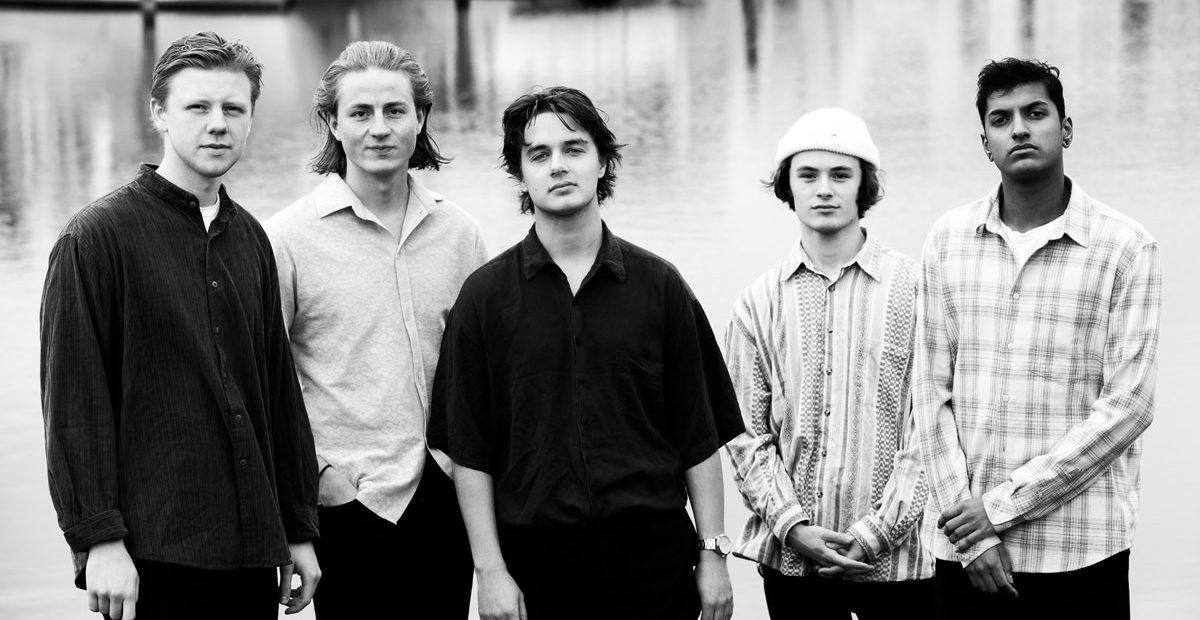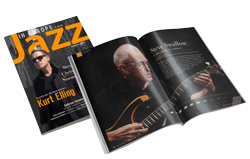Last year during Jazzahead! Club Night, a young Norwegian ensemble caught my attention during the club night – “The Bliss Quintet.” Originally, I hadn’t intended to stay for the entire evening, but the band’s performance in the first set left such an impression that I decided to witness both sets.
What struck me most was the remarkable maturity displayed in their playing and compositions, a surprising depth given the youthfulness of the band members. It was clear that there was something unique about their approach. Recently, the band released their second album, “Glasshouse,” on the Norwegian label Jazzland Recordings. This release further piqued my interest and provided an excellent reason to delve deeper into the band’s creative process and artistic journey so far.
In tracing the roots of “The Bliss Quintet,” pianist Benjamín Gísli Einarsson takes us back to the conservatory in Trondheim, where the band members’ musical journeys converged. “The origins of the band go back to the conservatorium in Trondheim, where all of the band members studied,” Benjamín shares, highlighting the pivotal role this institution played in the band’s formation.
Shedding further light on the multifaceted connections that weave through the band, Oscar Andreas Haug, the bands trumpet player, shared “It is funny because the band goes back on many different levels. Gard and Zakarias had gone through school together before the conservatorium and Zakarias and I knew each other from childhood. Benjamin moved from Iceland and didn’t know any of us before, but he was one of the initiative takers for forming the band. This mosaic of interconnected relationships, blending school ties and shared histories, laid the groundwork for a cohesive and collaborative musical venture.
As is often the case with emerging bands, “The Bliss Quintet” started by jamming together, a spontaneous exploration of musical possibilities. “Like many other bands, we started out just jamming, and quickly felt like we found a common sound together,” Benjamin recounts. The band’s unique character emerged as each member contributed their individuality to the collective whole. “We all had a common love for the older Nordic Jazz sound of bands like Masqualero and Jan Garbarek Quartet, and still look to these bands for inspiration today,” Benjamin adds, underscoring the enduring influence of the classic Nordic jazz tradition on their creative ethos.

Bliss Quintet, Live at Molde Jazz | Photo by Ole Bjørn Steinsvik
After hearing the band both live and listening to the studio recordings it’s clear “The Bliss Quintet” are not just a modern day replication of the Nordic sound of the 1980’s, however there’s an unmistakable resonance of this style within the roots in their sound. When speaking to the band, it’s clear that the acknowledgment of their musical heritage serves as a guiding force, shaping their artistic identity while allowing them to evolve into a distinctive voice within the contemporary jazz landscape.
Delving into the band’s conventional quintet lineup of saxophone and trumpet, along with the standard piano, bass, and drums rhythm section, I probed Benjamin about whether or not there was a conscious decision behind this choice. While the answer to this is a no, he speculated that their musical influences could have played a role, stating, “…it might have been a factor given that bands we dug had the same lineup. Atomic and previously mentioned Masqualero, for example.” However, he emphasized that in the band’s early days, the focus was more on the musicianship of each member creating a cohesive whole rather than a deliberate intention for a specific lineup.
Originating as a somewhat free improvisation band, “The Bliss Quintet” gradually incorporated more structure into their compositions as the members gradually started to introduced their compositions. Benjamin reflected, “…it was only later that we started to bring our tunes to band rehearsals. It started with Oscar’s tune Dramaqueen, which definitely carries the band’s initial sound of carefree improvisation. Dramaqueen ended up being our opening track on our debut album.” This evolution from free improvisation to structured compositions highlights the dynamic development of their musical approach.
Inquiring about the composition process within the band, particularly whether it is a collaborative effort, both Benjamin and Oscar concurred. “Sometimes the ideas start out smaller, like riffs or simple melodies that we will bring into the rehearsals, and other times the material will be more thought through from the beginning,” they explained. The collaborative nature of their rehearsals and the dedication to refining their compositions over time contribute to a sense of collective ownership of the music.
Addressing the perceived homogeneity in their material, I questioned how the band achieves a consistent sound. Both Benjamin and Oscar pointed to open communication and ongoing dialogue about the band’s sound. “When you hear some of the older legendary bands, you can instantly recognize who is playing. I think we are good at discussing what the Bliss Quintet sound is,” they expressed. While avoiding limitations, the band values curiosity and collective evolution, recognizing that tastes, expressions, and headspace naturally evolve over time. It’s clear after speaking with them that the band thrives on a continuous dialogue about their musical identity, allowing their sound to organically progress while maintaining a recognizable and cohesive presence.
Looking deeper into the band’s collective approach, it becomes evident that “The Bliss Quintet” operates as a cohesive entity, embracing a true collective spirit where leadership is not confined to a single member. The press release for their new album emphasizes a “democratically driven band-mentality,” prompting my curiosity about how this principle translates into practice. Benjamin explained, stating, “The ‘band-aspect’ is an important part for us when it comes to Bliss Quintet’s identity. We find the aspect of being a 5 person-driven band as a strength, as we try to use our different attributes throughout different areas within the band.” Despite the inherent challenges of a band format, they actively engage in discussions about the band’s current state and future, emphasizing the democratic and collaborative nature of their decision-making process.
We previously touched on the conventional jazz quintet line-up however within this the band does incorporate some interesting aspects in their instrumentarium such as quarter-toned trumpet, acoustic fretless bass guitar, and keyboards with a series of effects pedals. I wanted to know what impact this has on the compositional process, if any at all? In response, they shared, “Mostly, I think we like to focus on writing and making music for the individuals in the band more than the instruments. When we make use of different tunings and effects, they come more as a result of an intuitive thing or something that has organically appeared in rehearsals.” The emphasis on individuality within the collective, coupled with the organic integration of innovative instrument choices, contributes to the band’s distinctive sound.

Photo by Ole Bjørn Steinsvik
As mentioned in the introduction, the band has just released their second album, “Glasshouse” also on Jazzland Recordings. With the many options available today for artists to release recorded product, I was curious to find out more about. Benjamin revealed that Jazzland was a label they had aspired to collaborate with even before the release of their first album. The connection materialized in the lead up to the recording of “Dramaqueen” when Bugge Wesseltoft expressed interest in releasing ithe album. Benjamin shared, “We already had a tour lined up in the coming months and we were able to work closely with Jazzland to make the release of the album match the tour. We feel like it is a good collaboration, and it made sense for us to continue working with Jazzland for Glasshouse.” It’s obvious that this partnership highlights the alignment of artistic vision and practical considerations that characterize a good collaboration with a label.
Shifting the focus to their recently released album, “Glasshouse,” I inquired about the evolution of compositions compared to their debut album, “Dramaqueen.” According to Benjamin, “Dramaqueen” exuded a raw and unrefined quality, capturing a specific period of development during their Trondheim years. In contrast, “Glasshouse” presents a more developed yet abstract sound. The band explained, “The compositions on Glasshouse are more complex and took more time to develop into the album version.” The creative process for “Glasshouse” differed significantly, as the band members were physically apart, residing in Denmark and Germany during the material’s development, a departure from their time together in Trondheim.
Since the debut album “Dramaqueen,” The Bliss Quintet has consistently performed live in Scandinavia, with noteworthy showcase concerts in Germany and Italy. More recently, they’ve expanded their live presence to Belgium and the Netherlands. Eager to know about upcoming international dates, the band expressed their constant search for opportunities abroad. They happily announced a performance at Winterjazz in Copenhagen in February, with plans for more engagements in Norway during spring.
Wrapping up the interview, I delved into the band’s future plans. Currently, they are engaged in rehearsals for their third album, a renewed practice that wasn’t possible over the past two years due to their geographical dispersion. Also in the coming year, one of their primary goals is the further establishment of their presence on the wider European scene. There’s no doubt that the Bliss Quintet is a band that is not only driven to share their music globally but has the creative capacity to make this a reality.
You can read Steven James review of the bands latest release “Glasshouse” here. The album is available for streaming here and CD’s and LP’s are available on Bandcamp. More information on The Bliss Quintet can be found here at their website.
The Bliss Quintet consists of: Oscar Andreas Haug, trumpet | Zakarias Meyer Øverli, saxophone | Benjamín Gísli Einarsson, piano | Gard Kronborg, bass | Rino Sivathas, drums
Last modified: December 4, 2023















